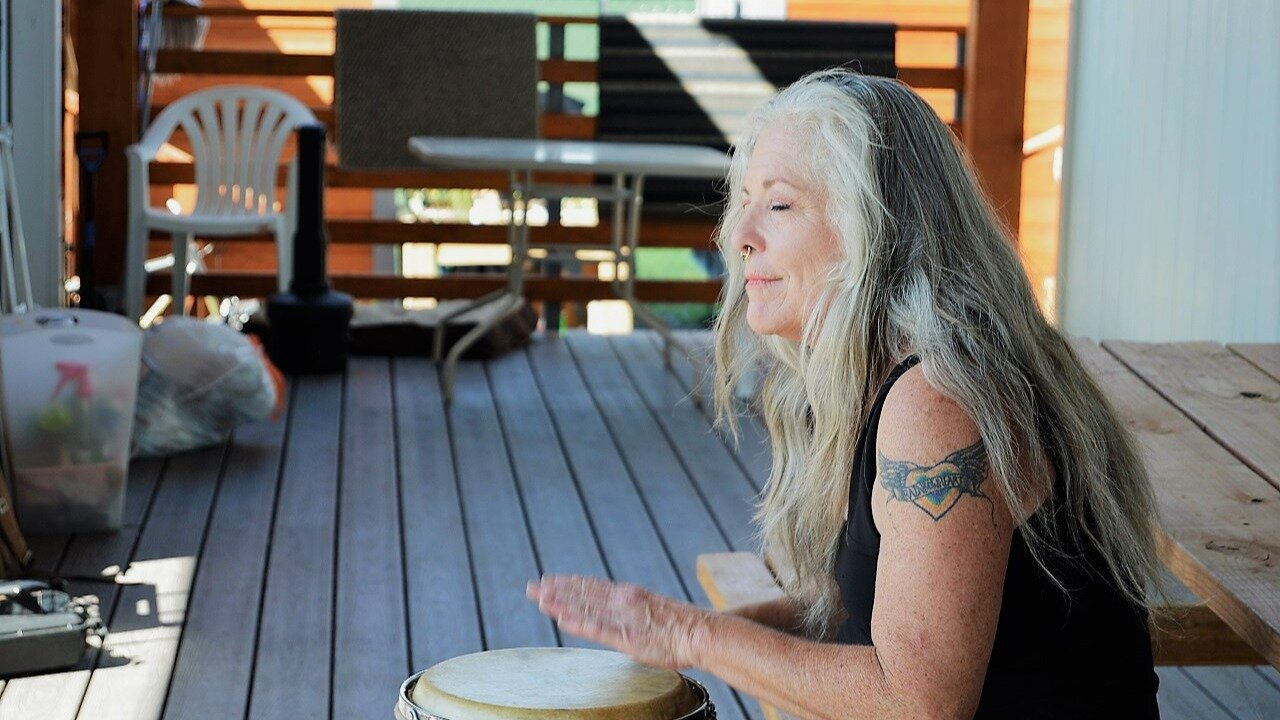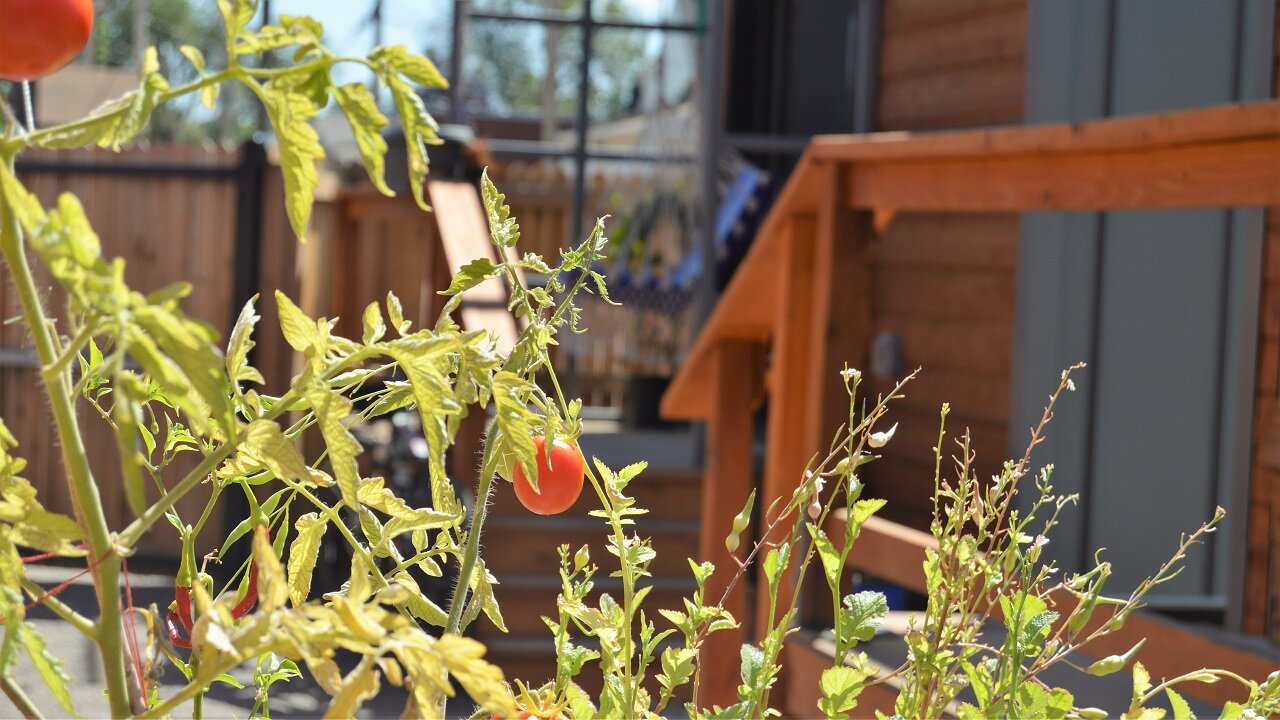Open for nine months, this tiny home village finds success in transitional housing

DENVER — On a hot afternoon in downtown Denver, 14 tiny homes and an accompanying trailer sit at the edge of a mostly empty field. These little mobile units have been a part of the Cole neighborhood for about nine months, and the women, transgender and nonbinary individuals inside those homes have become part of a new and different type of community.
“This is not like another place or this isn't like any other shelter I've been to; it's a unique model," said Hannah Fageeh. She is the coordinator of the Women’s Village at Clara Brown Commons run by the Colorado Village Collaborative.
The Colorado Village Collaborative, a nonprofit organization, works to create and run transformational housing for people who are experiencing homelessness. That means giving a person a place to live with the idea it won’t be long-term while providing them the chance to tackle the reasons they are experiencing homelessness.
In Denver, the number of people without homes has increased drastically over the past year. Moreover, the the number of people experiencing homelessness for the first time doubled since 2020, according to a point-in-time survey.
Related Stories
“So this COVID thing really, really put a challenge on everything,” said Tammy Vaughn, a 59-year-old resident of this village in the Cole neighborhood.
Vaughn is a self-described "hippie" and has lived and traveled all over the world. She has always considered Denver her home and until recently, never called herself homeless.
“I was very proud of myself for making a decision that I wanted to spend my adult life being a part of Denver and investing my life in Denver. And it was very discouraging to find that even with a job downtown I became homeless,” explained Vaughn. “It's the only time I've ever called myself homeless because it was not by my intention that I was living the way I was. And I was working, which I want to say sucks worse than just deciding to go camp out.”
Vaughn had a career in nursing for most of her adult life and stopped only when her husband became ill. She became his caretaker and after he passed, she found it too difficult to go back to nursing.

“It was just, I was too emotional and it just wasn't a good thing anymore,” said Vaughn. “I wanted to be able to go home and not have to think about work anymore. You know what I mean? Like go home and it's over.”
In the time leading up to December 2020, Vaughn said she was sleeping outside most of the time, often in a sleeping bag down near Sheridan Boulevard by the W line, the RTD light rail line that goes from Denver to Golden. She explained that she didn’t like a lot of the shelters because she often felt like they had an “agenda” when offering help to the houseless community. Then she found out about this tiny home village.
“I was told about an opening and invited to come and take a look at a place on December 23rd. And I took a key with me that afternoon and came back on Christmas Eve and moved in,” Vaughn told Rocky Mountain PBS.
Having been at the village for a little longer than eight months, Vaughn is glad that she has been able to be a part of shaping this community.
“It's good to get to know people and it's kind of nice because … we're sort of developing it as we go," Vaughn said.
Right now there are 11 people living in the tiny homes; a couple of the home are being renovated. Each home has a bed, air conditioning and heating, a small space for other essentials, plus a porch. The bathroom, kitchen and laundry are all shared in one trailer that residents have coded access to.
A fence surrounds the homes with a secure gate and cameras to help the residents feel as safe as possible, but the goal is not to overstep. Fageeh points out that the village is different from a shelter, so they don’t have staff there 24/7.
“We don't want people to feel like they're being monitored all the time,” explained Fageeh. “Those are conversations we're actually always having all the time with residents. And we recently did, like, a climate survey for residents to get feedback so we can improve upon things ourselves because we're a really small organization. We're always growing and trying to learn as much as we can.”

This hybrid model of housing and shelter does come with support services and other activities. There are health and wellness classes, support to apply for jobs or permanent housing and a program that helps residents build small gardens outside each of their homes. All of it is very community-based with bi-weekly dinners in the common area for the residents.
“Now that I think everybody has gotten to know each other, there’s a larger sense of community and reliability on one another,” said Fageeh. “And of course we all have conflict and things we have to work through, but for the most part, I’ve seen residents get to know each other and come together which has been a really cool experience too.”
Vaughn agrees that living in this village really has its benefits. But she also admits it can be hard living in such close proximity to other people.
“Honestly, there are days that I find...now that it's summertime again, that I find going past my lips that, you know, ‘Gee, I'd like to be out in my tent’ because there is something to be said about, we are a women's village here,” said Vaughn. “And women have their own thing and they can be pretty loud. And I don't know. So sometimes, you know, there's people who've got their issues going on and when we all sort of hear about it sometimes, and it can be a little disruptive. But, you know, I guess you can expect that in lots of places, even just living in apartments in places I imagine, depending on who your neighbors are.”
While a sense of community is important for Colorado Village Collaborative in these tiny home villages, there is a real logistical hurdle of where to put the tiny homes. In 2019, the organization successfully campaigned to get the Denver City Council to pass new codes allowing the homes to stay in one place for four years. That gives this place a little more than three years to find another spot to move to.
“I think something that we face that is challenging as an organization is moving,'' explains Fageeh. She said paying for hotels for residents as they move, then the actual cost of moving the homes and community trailer can really add up. “So our goal in the long-term is to have a piece of land where we can stay, where we could have, like, different tiers of housing. Like we could have the alternative sheltering model of tiny homes, but then maybe other types of tiny homes where people could actually rent them and stay long-term.”
The idea of moving the homes also comes with another major challenge besides money: tackling the stigma of houseless individuals, something Vaughn believes Colorado Village Collaborative is doing a good job of addressing.
“Where homeless people are looked at as just homeless," Vaughn said. "Not like they're probably criminals or probably drunks, or probably contagious, or probably mentally ill or, you know, whatever, all those sort of stereotypes."
Fageeh believes the Cole neighborhood has really grown to accept the tiny home village and that is partially due to efforts Colorado Village Collaborative put in to fight those stigmas.
“We try to do open house events and things that can show people, you know, these are just normal, everyday people … We all just need help sometimes and a place to stay,” said Fageeh.
As far as figuring out where this village might relocate in a few years, they’ve got time. Fageeh says they’re focusing on their current residents as they hope to get people to permanent housing within six months, although people can ask for extensions.
For Vaughn, this is a nice place to be for now. She can sit on the community porch, play her drum and relax after biking home from a long day’s work.
“I'm really fortunate that here I'm, you know. I can do my goals and I can have the support I need from the various organizations that do come through here for what I'm doing. It's a little unconventional," Vaughn said with a smile. “But I have an Airstream trailer that I'm working on. If I had a place to put it right now, I'd be in it.”
While Vaughn’s future looks like it might be more on the road, she really hopes this tiny home model can be adopted for more people as home prices in Denver continue to increase another 15 percent from last year.
“One organization who was talking about, like, people should maybe get an annual stipend or whatever, just flat out from the government, you know, something to help them be able to afford stuff or whatever,” said Vaughn. “Why not just give people a home? There [are] places … empty buildings all over the place. Really are we that greedy that we price renters like myself who were working out of being able to afford a place to live?”
If you or someone you know wants to apply for a tiny home, you can visit the Colorado Village Collaborative website.
Amanda Horvath is a multimedia producer with Rocky Mountain PBS. You can email her at amandahorvath@rmpbs.org.
Alexis Kikoen is a multimedia journalist at Rocky Mountain PBS. You can reach her at alexiskikoen@rmpbs.org.